Coins were the primary form of currency in ancient China. Ancient Chinese coins play a vital role as they help in researching the history of the economy in ancient times. Since Chinese coins were used as a currency in ancient times, it is no surprise that they represent abundance and wealth. Ancient Chinese coins are considered one of the eight treasures, along with stone chime, pearl, mirror, lozenge, book, rhinoceros’ horn, and leaf, all symbolizing prosperity and good fortune. This article will discuss the ancient Chinese coins, so you can learn what they were made of, who used them, their history, different types of coins, their manufacturers, their meaning, how many are lucky, and their worth.
What is old Chinese Coins?
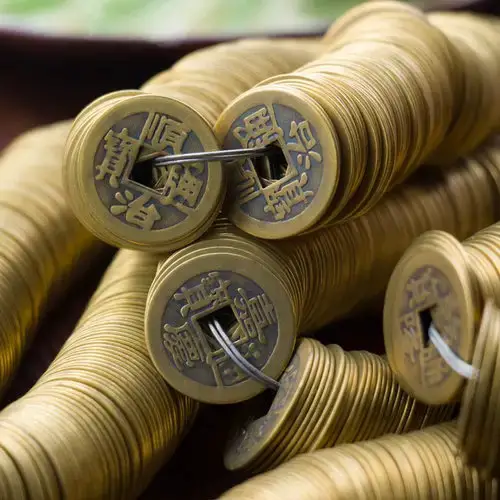
Ancient Chinese coins include some of the earliest recognized coins. The old Chinese coins were used during the spring and autumn period between 770-476 BCE. Ancient Chinese coin, the cash or qian, was used in East Asia and China. Cash was used from the 4th century BC to the 20th century AD. The old Chinese coins took different forms and shapes and were used in ceremonial exchanges. Cash coins were originally made during the Warring States period and continued to be utilized throughout the whole of imperial China, with the last Chinese cash coins being cast during the first year of the Republic of China.
What are ancient Chinese coins called?
Chinese ancient coins came in different forms depending on the period they were produced. Spade money was one of the old Chinese coins mainly used in China’s Zhou dynasty. Spade money resembled a weeding tool or a spade. There were different types of spade money, including the hollow handled spade money and flat-handled spade money. Knife money, which resembled actual knives, was also used during the Zhou period. The round coins, the forerunner of the familiar cash coin, were also circulated in the Zhou period and came in different types, including Ban Liang coins and Western Han and Wu Zhu coins. Cash coins came later in the 4th century and were characterized by a square center hole and round outer shape, called tong qian. Therefore, the ancient Chinese coins had different names and were also used in different periods.
What were ancient Chinese coins made of?
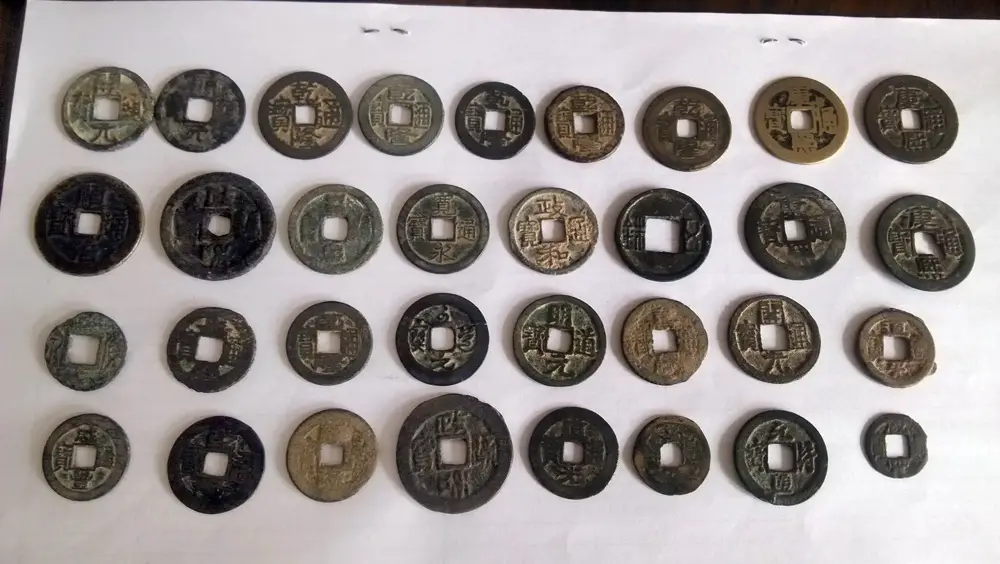
Ancient Chinese coins are made significantly different from those of European origin. Ancient Chinese coins were made by being cast in a mold. The primary materials used to make the ancient Chinese coins include bronze, copper, brass, tin, iron, and lead, whereby the purity and ratios of the metals used varied considerably. On rare occasions, precious metals such as silver and gold were also used to make the coins. Most ancient Chinese coins were made with a hole, allowing them to be threaded on strings for easier handling. Cash coins were initially cast but were later machine-struck during the late Qing dynasty.
Who used ancient Chinese Coins?
When the production of ancient Chinese coins began, their use and distribution were restricted to the capital city district. However, during the Han Dynasty, Chinese coins were widely used for different things, such as salaries, paying taxes, and fines. People also used the coins as a medium of exchange for different items such as agricultural commodities and farming tools.
History of Chinese coins
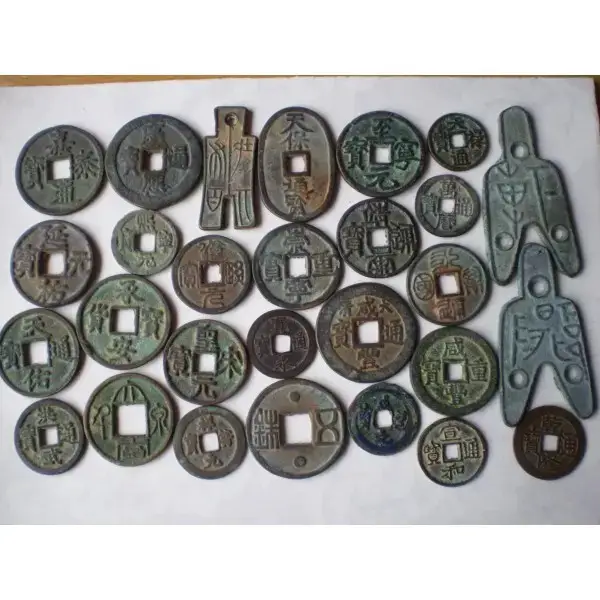
Chinese cash coins came from the barter of agricultural commodities and farming tools in ancient China. People started using smaller farming tokens, such as hoes, spades, and knives, to conduct smaller exchanges around 1200 BC. The tokens later became widely known as knife money and spade money and were used as a media of exchange.
During Imperial China, standard circular coins were created after China unified with Qin Shi Huang. The typical form of the cash coins was round-shaped and made from copper, with a circular or square hole in the middle. The early Ban Liang cash coins resembled wheels the same way ancient Chinese coinage forms were based on agricultural tools.
The early round coins that were similar to the ancient jade circles in the Warring States period are believed to have symbolized the round shape of the sky, and the hole represented planet earth. The coins’ body was referred to as the flesh, while the hole was the good.
The Han Dynasty introduced the San Zhu cash coins and Wu Zhu cash coins after the Ban Liang cash coins. Wu Zhu cash coins were manufactured from 118 BC to 618 AD, making it the longest time for any coin in the history of the world, lasting 736 years. The last Chinese cash coins were not cast but were metal-struck and were phased out after the fall of the Qing Empire in favor of Yuan-based coins.
Types of Chinese coins
The earliest Chinese coins were in the form of cowrie shells. However, metal coins were later introduced. As shown below, the shape and metal used to make the Chinese coins changed during different regimes in Chinese history.
- Pre-Imperial coins
Cowrie
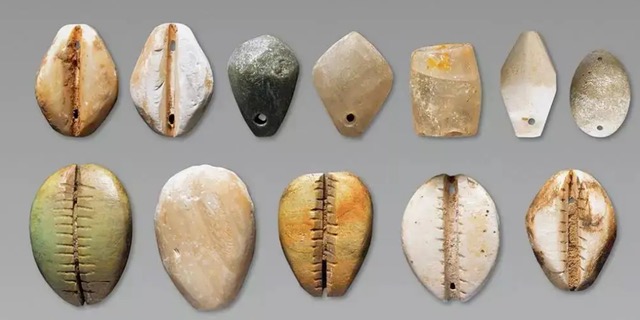
During the Shang Dynasty, cowrie shells were used as rewards or gifts from kings to their subjects. Later, imitations of cowrie shells were used as money in some scenarios. Even the first Chinese metallic money is thought to have been bronze imitations of the cowrie shells found in an ancient tomb (dating 900 BC) near Anyang.
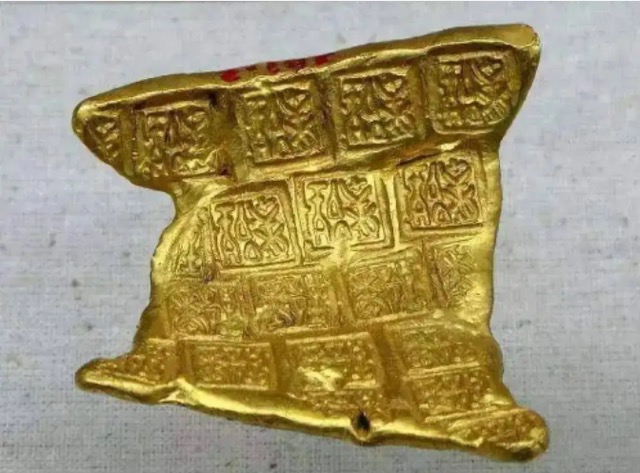
The only gold coinage from the pre-imperial period is the Chu gold block money which comes in the form of gold sheets-3 to 5 millimeters, different sizes, with square or round stamps.
Jade pieces
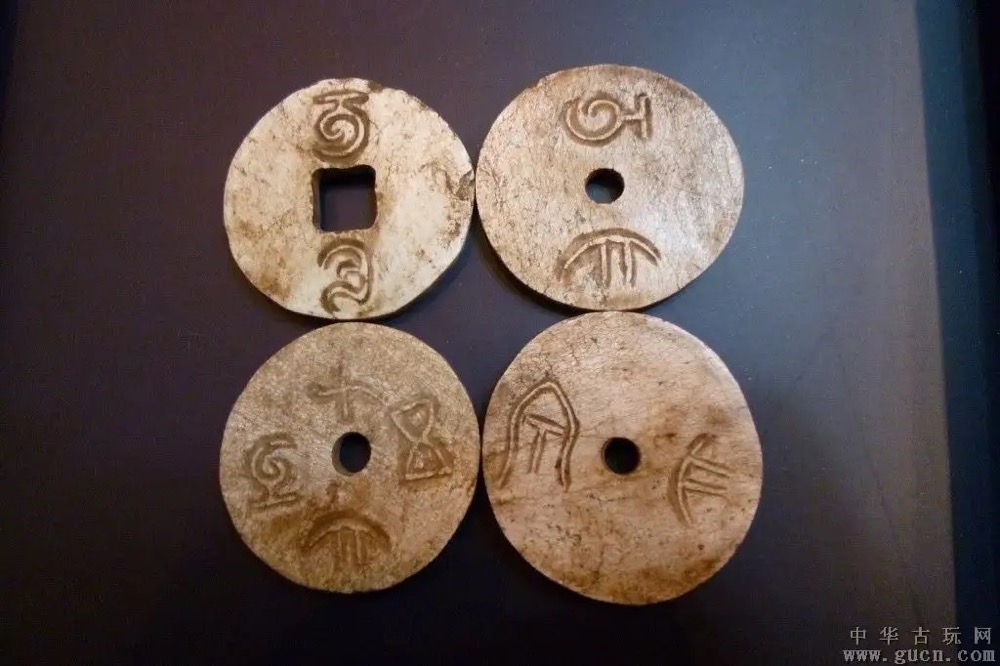
Suggestions exist that jade pieces were used as money during the reign of the Shang Dynasty.
Money brand
Metallic money brands were barely in use in the State of Chu. They were only reintroduced during the Song Dynasty.
Spade money
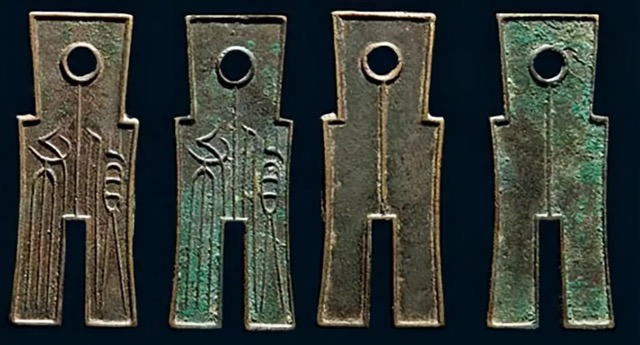
The main spade monies used during the pre-imperial period were hollow-handled and flat-handled spade monies.
Knife money
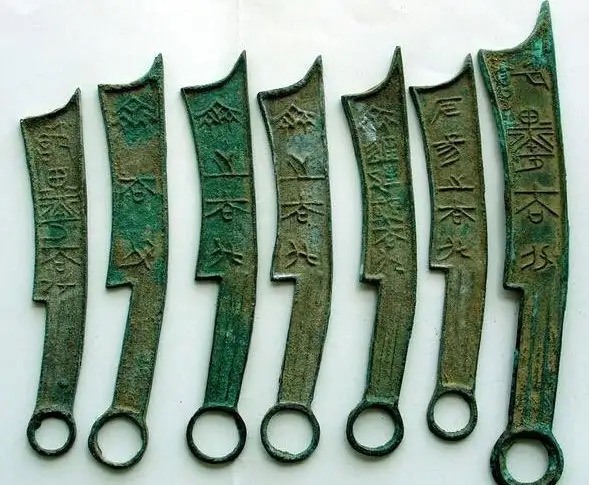
The Chinese knife money is an imitation of the actual knives and was mainly used during the Zhou period. The knife money appears to have been in use during the same period as the spade money.
Early round coins
The round coin, the predecessor of the renowned cash coin, was in use during the same period (Zhou period) as the knife and spade money from around 350 BC. Other the two late coins from the State of Qin, coins from the regions that used spade money have a round hole, while those from areas that used knife money have a square hole.
- Ban Liang coins
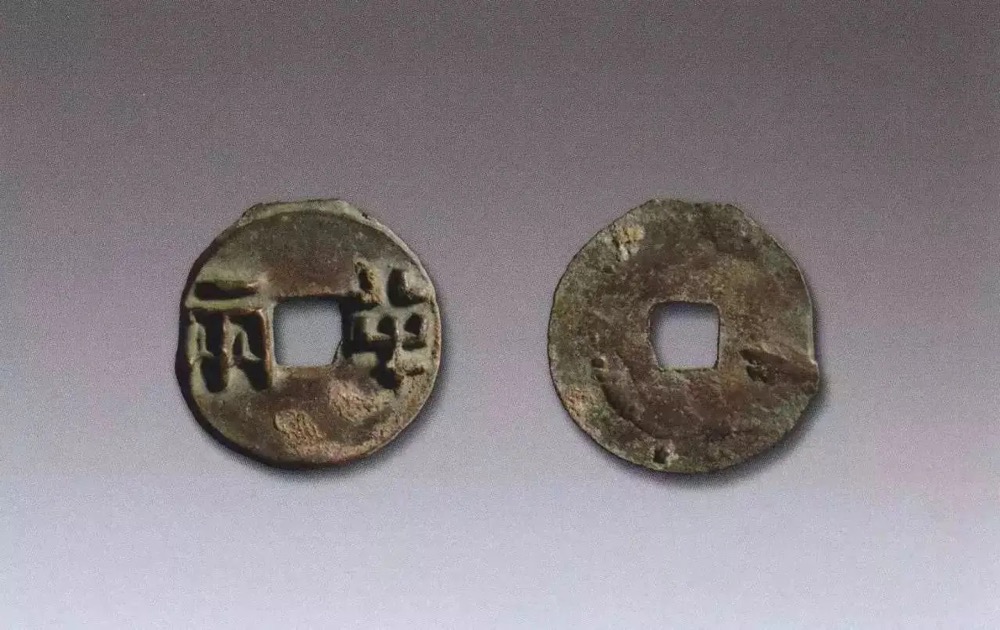
The coins get their name from the inscription on their face-Ban Liang, which means half a Liang. The coins are linked to Qin Shi Huang Di, the first emperor to unite China in 221 BC.
- Western Han and the Wu Zhu coins
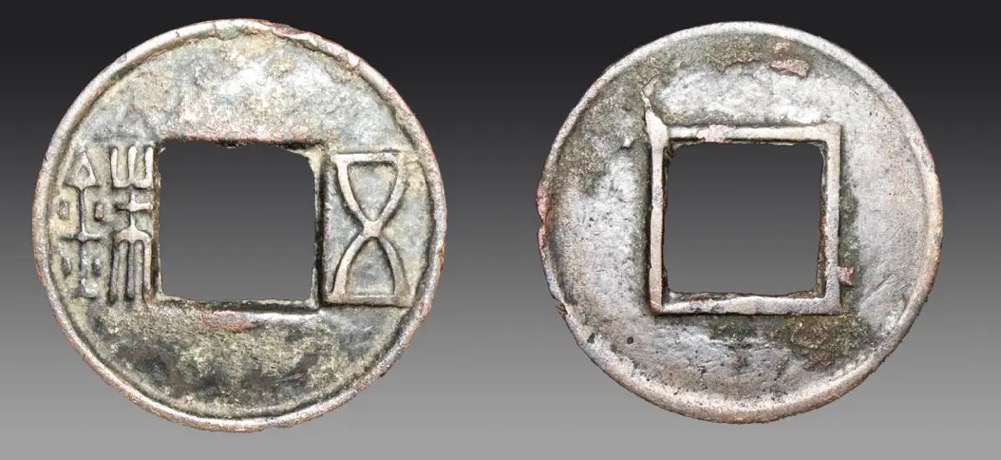
China developed into a full monetary economy during the Western Han period. Fines, salaries, and taxes were paid in coins. During the period, more than 26 different coins were minted. The first coin during the period was the San Zhu coin, and the last was the small coins without characters.
- Wang Mang coins
In 9 AD Wang Mang seized the throne and introduced several currency reforms. For instance, in AD 7, Wang Mang authorized the retention of the Wu Zhu coin but brought back 2 versions of knife money. Later the emperor oversaw the introduction of a complex monetary system involving cowrie, tortoiseshell, silver, gold, spade money in 10 denominations, and 6 round copper coins.
- The Three Kingdoms coins
After the Han Dynasty regime ended in 220, the Three Kingdoms period began. Each of the three kingdoms had its own money. The Cao Wei Kingdom used Wu Zhu coins; the Shu Han Kingdom used the Zhi Bai Wu Zhu, Zhi Bai, Tai Ping Bai Qian, Zhi Yi, and Ding Ping Yi Bai coins; lastly, the Eastern Wu kingdom used Da Quan; Wu Bai, Dang Qian, Er Qian, and Wu Qian coins.
The use of different coins by the three kingdoms symbolized the division in China during the period.
- The Jin Dynasty and the 16 Kingdoms coins
The Jin Dynasty was established in 265, and China experienced a short stint of unity during this period. During the Jin Dynasty, no coins were cast.
However, in South China, a reduction in coin weights led to significant price fluctuations leading people to use cloth and grains as substitutes for the coins. Conversely, the 16 independent kingdoms in North China used interesting coins such as the Feng Huo (the coin of abundance), Liang Zao Xin Quan, and Han Xing.
- The North and South Dynasties coins
China went through a long period of strife and disunity during this era. During the period, China was ruled by two prominent dynasties.
Three dynasties ruled the Southern Dynasty. First is the Song Dynasty, which issued Si Zhu, Xiao Jian, Jing He, Yong Guang, and Liang Zhu coins; second is the Liang Dynasty which issued the Tai Qing Feng Le coin; last is the Chen Dynasty which issued the Tai Hou Liu Zhu coin.
Northern Dynasty consisted of three dynasties. The first is the Northern Wei dynasty, which issued Tai He Wu Zhu and Yong An Wu Zhu coins; the second is the Northern Qi Dynasty, which issued the Chang Ping Wu Zhu coin; last is the Northern Zhou dynasty which issued Bu Quan, Wu Xing Da Bu and Yong Tong Wan Guo coins.
3 and 4 Zhu cash coins were also used during the Northern and Southern Dynasties. The 3 and 4 Zhu coins consisted of; small round and square coins that do not always feature a hole in the middle.
- The Sui Dynasty
In this dynasty’s era (581-618), China regained its unity. The only coin used during this period was the Wu Zhu coin.
- The Tang Dynasty
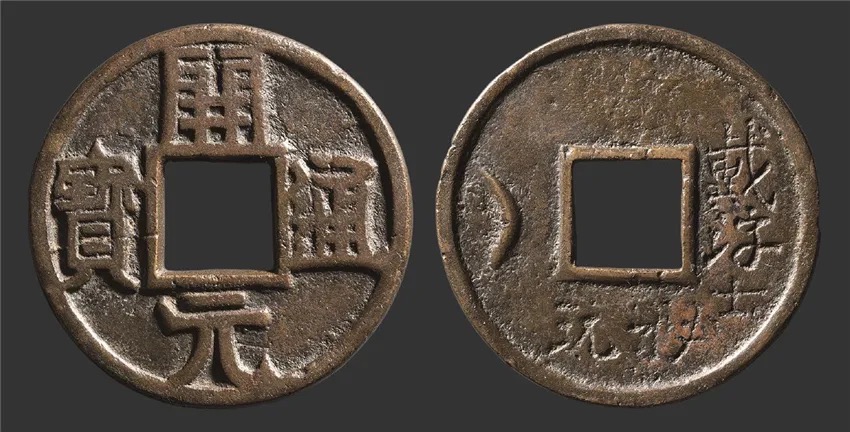
The main coin issued during the Tang Dynasty era was the Kai Yuan Tong Bao. Other coins during this period include the Qian Feng Quan Bao and Qian Yuan Zhong Bao.
- The Five Dynasties and Ten Kingdoms
After the fall of the Tang Dynasty, another long period of disunity began. During this period, 5 dynasties emerged in Northern China and 10 kingdoms in Southern China. Each of the 5 dynasties and 10 kingdoms had its coin(s).
- The Northern Song Dynasty
After the Five Northern Dynasties, the Northern Song Dynasty was established in 960. The production of bronze coins increased after the discovery of new copper mines. A wide variety of song coins were minted during the era. Inscriptions on coins from this period include tong bao, yuan bao, and Zhong bao for the large coins.
Chinese coin cash manufacturer
Chinese coins were manufactured by mints set up in different regions in China. For instance, during the Northern Song Dynasty, Chinese coins were produced by 17 mints, each producing 200000 coins annually. The largest mint was located in Guangdong and was named Shao Zhou. In 1889 a machine-operated mint was set up in Guangzhou and immediately became the primary producer of Chinese coins.
Meaning of Chinese coins
Chinese coins were used as the official currency in Ancient China. Therefore, one can only postulate that the coins represent wealth and abundance. The coins are considered one of the 8 Chinese treasures representing prosperity and good fortune.
Chinese coins in Feng shui
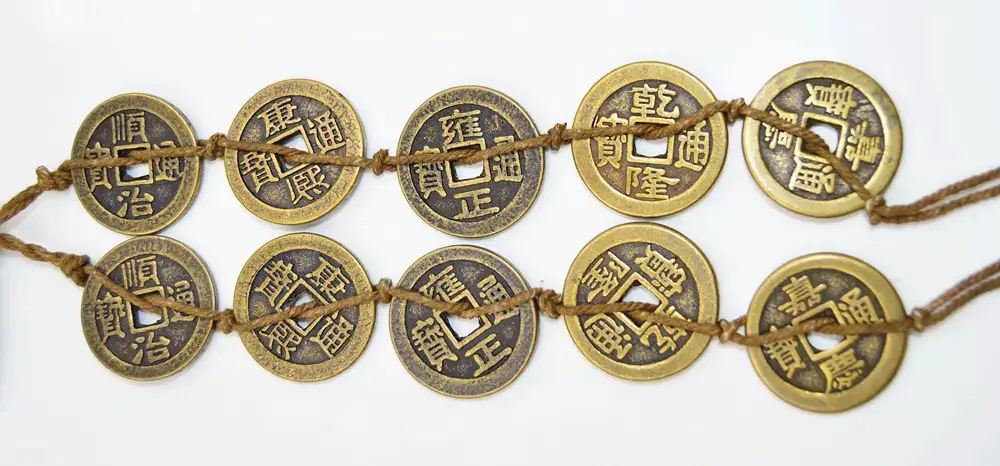
In Feng Shui, Chinese coins represent wealth and abundance. The coins are in the top 8 list of Chinese symbols of good fortune. The coins were made of copper.
How many Chinese coins are lucky?
9 Chinese coins are considered lucky coins. It would be best if you hung them on a red cord or gold chain to amplify their power.
How much is a Chinese cash coin worth
Antique Chinese cash coins are worth a fortune, and some are hard to find. The coins are made of copper. Therefore, you can purchase a replica if you cannot find the antique version. The replicas are made of gold, jade or other precious materials to boost their symbolism.
Conclusion
Ancient Chinese coins were the main media of exchange in the nation. Due to their rich history, they can be used to analyze the history of the commercial economy of ancient times. This article has provided information about everything you need to know about ancient Chinese coins.